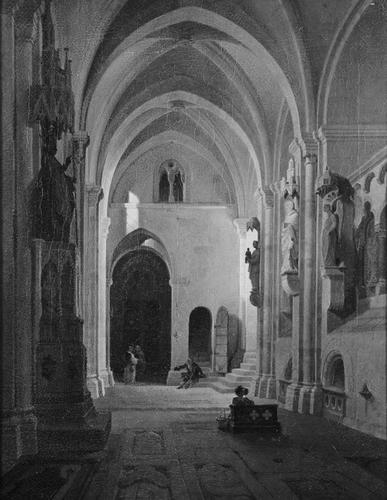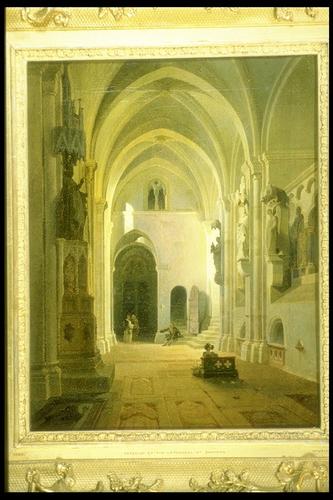-
1 of 253523 objects
Interior of the Cathedral at Bamberg 1843
Oil on canvas | 45.6 x 37.1 cm (support, canvas/panel/stretcher external) | RCIN 403703
-
Maximilian Albert Hauschild (1810-1895), a painter of architectural subjects, was a student of architecture at the Academy in Dresden, where he was later appointed an assistant teacher. He made several trips to Rome; in 1838, 1841, and 1846. From 1852 he lived alternately in Dresden and Italy, before settling permanently in Naples. He is known particularly for his paintings of church interiors; his view of the interior of Milan Cathedral was recently sold at auction.
The Imperial Cathedral of St Peter and St George at Bamberg was founded in 1002 by the emperor Henry II, finished in 1012 and consecrated in 1012. It was partially destroyed by fire in 1081, and the new cathedral, built by St Otto of Bamberg, was consecrated in 1111. The thirteenth-century construction, incorporating stylistic elements of the late Romanesque and early Gothic periods, has survived to the present day. Many of the sculpted figures adorning the interior date from this last period of building, known as the Hohenstaufen era; they include the allegorical figures of Synagogue and Ecclesia, a Visitation group and the laughing angel.
Four figures can be seen within the interior of the late Romanesque cathedral of Bamberg, at the far end of an ambulatory framed by pointed arches. Two figures converse beneath an archway leading to a darkened side aisle whilst a man begging, leaning upon a crutch, sits at the foot of a stairwell. A female figure in the foreground kneels at a pre-dieu with a basket placed beside her. Along the ambulatory are regularly spaced tabernacle framings which contain figure sculptures.Provenance
Acquired by Queen Victoria in 1843
-
Medium and techniques
Oil on canvas
Measurements
45.6 x 37.1 cm (support, canvas/panel/stretcher external)
72.7 x 62.8 x 7.9 cm (frame, external)
Category
Object type(s)
Alternative title(s)
Interior of the Bamberg Cathedral

